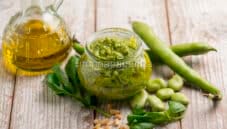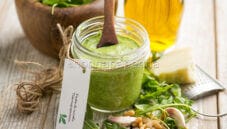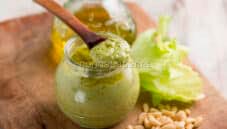
Genovese Basil Pesto: a timeless classic

Genovese Basil Pesto, the recipe for bad days!
Despite our love of cooking, the Genovese basil pesto always saves the day when we are experiencing those infamous “bad days.” Maybe ready-made pesto is a blessing to relieve our concerns about what to eat when we have flu, fever, aches and pains, and don’t feel like getting out of bed. Sometimes, we are in a hurry, other times we have to leave something ready; in short, the right occasions to eat basil pesto are never lacking!
One of my husband Gabriele’s specialities is the Genovese basil pesto, which he makes when I’m not feeling well and he wanders around the kitchen. He occasionally enjoys experimenting with pots and pans as well, so for a few hours—perhaps due to force majeure—I give him the place of honour! I have to “give to Caesar what belongs to Caesar” and know that a nice plate of pasta with pesto is sometimes enough to get me back in good health! Among the first courses that I often use with pesto are trofie, trenette, or testaroli.
Do you know testaroli? We are dealing with a type of fresh pasta that is mainly seasoned with pesto. These two ingredients combine their stories and their flavours in a simple and, at the same time, tasty dish. Both adults and kids like this satisfying and interesting first course, which is free of gluten and lactose. So, what do you think? Do you want to try preparing it?
Recipe Genovese basil pesto
Preparation Genovese basil pesto
- You need to prepare all the ingredients on the work surface before even starting with the preparation of the sauce.
- The basil leaves should first be cleaned by running them under fresh water.
- Gently pat the leaves with a clean cloth to dry them. Then peel a clove of garlic.
- Using mortar is the best way to obtain a handmade pesto. In the marble mortar, add the pine nuts, garlic, basil, rock salt, and a teaspoon of oil. Then, pound slowly and for a long time.
- Add the oil a little at a time, as needed. You will have to continue pounding until the leaves and the ingredients are completely crushed.
- You will end up with a cream with an intense green colour and a strong flavour. The cream must be soft.
- Next, transfer the basil pesto into a bowl and stir in the grated cheese until fully incorporated.
- Put all the ingredients in the blender if you don’t have a marble mortar or if you don’t have much time. When preparing pesto in a blender, keep in mind that a few extra tablespoons of oil will be required.
- Proceed by blending in pulses to prevent the mixture from overheating, since heat will compromise the flavour.
- Pour the mixture into a basin and stir in the cheese until smooth, just like you would with the pesto in a mortar.
- Pour the Genovese pesto into sterile jars after it has been prepared, but leave them open for about two hours before hermetically closing them. Cover the opening with a piece of wax paper while it rests.
- After a couple of hours, you will notice the oil emerging on the surface, isolating the pesto from the air and ensuring better conservation.
- At this stage, hermetically seal the jars and add more oil if it appears that there is not enough.
- You can store the pesto in this way for several months and it will still be edible, although the initial green colour will tend to darken over time.
- This pesto can be added directly to the pasta. If you add it to trofie pasta, you can dilute the pesto with a little of the cooking water to make it creamy.
- In less than 30 minutes, the Genovese pesto is ready to pair with any pasta!
Ingredients Genovese basil pesto
- 100 gr. Genovese PDO basil leaves (or nickel-free Sfera basil)
- 2 cloves of garlic
- 50 gr. pine nuts or cedar pine nuts
- 30 gr. grated aged Pecorino cheese
- 70 gr. grated Parmigiano Reggiano cheese
- 200 gr. extra virgin olive oil
- a pinch of rock salt
The pesto was prepared “with you in mind!
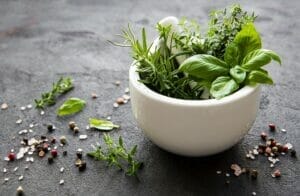 You have no clue how valuable a good-quality Genoese pesto can be as a pantry staple. Are your children away at university? You couldn’t give them a better gift than jars of ready-made sauces, pestos, or gravies! We know that university life—the first few years away from home, not only studying—but also work commitments—can be particularly oppressive. In these conditions, the desire to cook and eat well is often not a priority. So what do you do? Away with ready-made dishes, pizza, and fast food, and jump into the kitchen.
You have no clue how valuable a good-quality Genoese pesto can be as a pantry staple. Are your children away at university? You couldn’t give them a better gift than jars of ready-made sauces, pestos, or gravies! We know that university life—the first few years away from home, not only studying—but also work commitments—can be particularly oppressive. In these conditions, the desire to cook and eat well is often not a priority. So what do you do? Away with ready-made dishes, pizza, and fast food, and jump into the kitchen.
Would you like to prevent your loved ones from using these preservative-laden resources? You can make it easier for them by keeping jars of homemade, ready-to-use pesto in the cabinet. Another good idea is to give pesto, sauce, or salsa to new mothers. I have discovered, from experience, that when you have to deal with a small, adorable newborn baby with hours of sleepless nights and millions of things to take care of, having a healthy and ready meal is an invaluable gift! Try it, and you will read pure gratitude in their eyes.
A powerful creamy antioxidant
When we prepare pesto alla genovese, which is a typical Ligurian recipe, with fresh basil and pine nuts, we bring an excellent natural antioxidant and anti-inflammatory substance to the table. Basil also contains vitamin K, vitamin A, beta-carotene, manganese, vitamin C, copper, volatile oils, and flavonoids.
We give ourselves remarkable nutritional qualities that can heal our bodies from the inside out when we use basil in pesto and to season our meals. And for our health, what could be better than homemade pesto? Just choose zero-mile and strictly organic ingredients to keep you healthy!
Are you familiar with pesto preservation?
It’s not as clear-cut as you may think. Additionally, although the recipe is straightforward, it has certain unique qualities, particularly with relation to the ingredients’ long-term preservation. Since we frequently feel the desire for a quick meal and to cut down on time spent in the kitchen, asking the question is helpful. What’s better than a good-quality, home-made sauce? Read the article on how to best preserve pesto.
Is it possible to enhance the recipe for basil pesto?
The recipe for basil pesto is well-established and a part of Italian culture in every way. You are still free to alter it and even make it better to suit your preferences.
For instance, you can use almonds in place of the pine nuts. This will result in a pesto that is softer, possibly less gritty, but still appropriate for palates who prefer milder flavours (hence better suited for kids).
However, you can pair the basil with some fragrant herbs like sage and parsley. In the first case, you will get a slightly more bitter but still delicious pesto. In the second case, the pesto will take on a more rustic and almost wild flavour. The advice is to experiment, keeping in mind the specifics of each ingredient.
How to make Genoese pesto without a mortar
The mortar is an integral part of the traditional Genoese basil pesto recipe. Specifically, marble mortar with a wooden pestle is used. Obviously, a wooden mortar is also fine, although this material tends to “capture” some of the ingredients and may be more difficult to clean.
Not everyone has a mortar and pestle, but fortunately you can also use a blender or food processor. This way you will save time and still get a good pesto. Be careful; a smoother and less grainy pesto is certainly more suitable for seasoning pasta but less satisfying to the palate.
Precisely for this reason I recommend using the “pulse” function, where available. This allows you to check the consistency of the pesto from time to time, adding oil or boiling water as needed.
What are the right doses to make pesto?
The secret to making a good pesto does not lie in the use of a mortar, pestle, or blender, but in using the right dose of ingredients. Citing the precise grams is useful but a little inconvenient, as it does not offer clear references if you decide to prepare a larger or smaller quantity than that suggested by the recipe in question. Therefore, it is better to talk about proportions.
So what are the right doses to make an excellent pesto? In theory, you should use two parts basil for one part pine nuts, balancing with plenty of extra virgin olive oil until you get the right consistency.
You also use two parts Parmigiano Reggiano cheese and one part Pecorino cheese to add flavour. Garlic is used sparingly, generally one clove for every two handfuls of basil. Salt, on the other hand, is added to taste, but without exaggerating so as not to overpower the delicate flavours of the other ingredients. You can eventually add a few drops of water to adjust the density of the sauce.
Genovese basil pesto FAQs
What tool should you use to make pesto?
Traditionally, pesto was made with a marble mortar and wooden pestle, but today a blender or food processor is often used to speed up the process.
What type of pasta pairs well with pesto?
The most common type of pasta for pesto is trenette, but trofie, linguine, or spaghetti also go well with this Ligurian sauce, enhancing its fresh flavour.
What type of cheese is used for pesto?
Parmigiano Reggiano and Pecorino cheese are generally used; they give the sauce the right balance between sweet and salty flavour.
Who invented the basil pesto?
Basil pesto was born in Liguria, but the “inventor” is not known. We only know that it appeared in the late Middle Ages, when the production of aged cheeses made its appearance in Italian culinary history.
How to wash basil leaves for pesto?
To wash the basil leaves, immerse them in cold water, shaking them gently. Then drain them and dry them carefully by dabbing them with a cloth or with absorbent paper.
Do we have any pesto recipes? Of course we do!
COULD IT BE INTERESTING FOR YOU

Strawberry tree vinegar, excellent for vegetables and side...
How to choose the strawberry tree fruit In order to prepare a good strawberry tree vinegar, it is advisable to choose the fruit carefully. For this type of vinegar, slightly ripe strawberry tree...
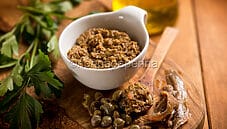
Caper sauce, a special condiment that requires no...
A focus on capers The protagonist of this sauce is obviously capers, a recurring presence in many traditional recipes, especially in southern Italy. Capers are particularly useful as a key component...

Taramosalata, a colourful and aromatic Greek sauce
All the deliciousness of Mullet roe What makes taramosalata unique is that its primary ingredient is mullet roe. It must be noted, nevertheless, that certain Middle Eastern variations—despite...



